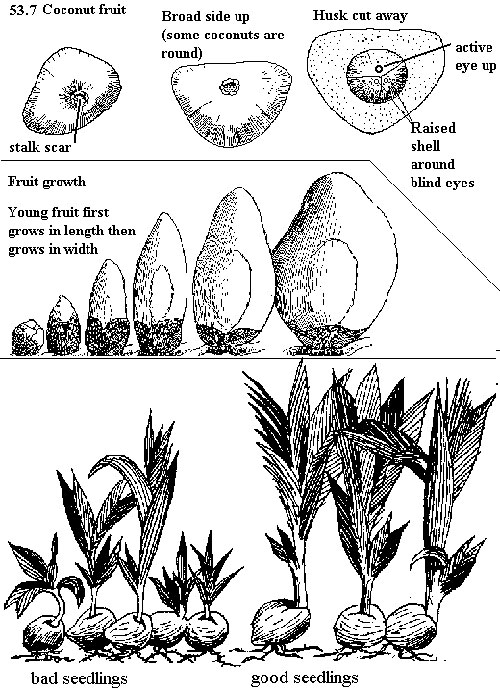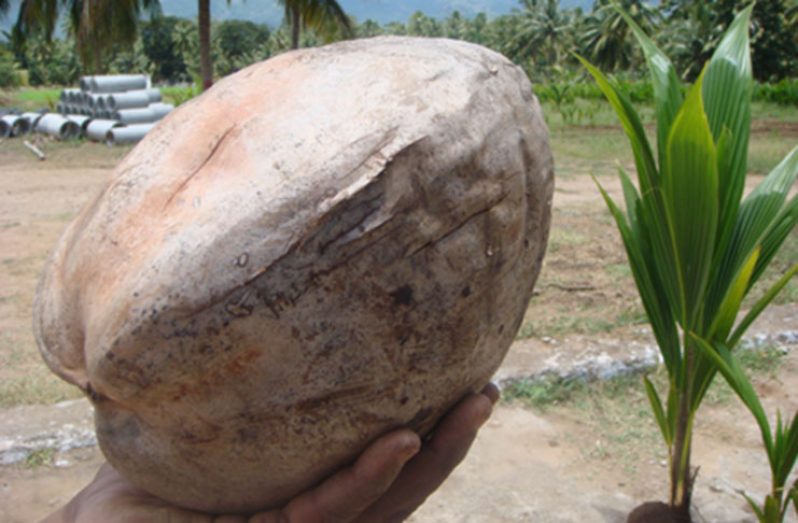Last week the National Agricultural Research and Extension Institute (NAREI) shared a coconut factsheet highlighting pertinent information such as soil type suitable for palm growth, germination and flowering.
This week, the Institute wishes to educate farmers about the selection of proper mother  palms for seednut production. Success of a viable coconut plantation starts with the utilization of high quality planting materials. Consequently, extreme care should be taken in choosing seedlings to start a plantation. This is especially so since poor planting material will produce low yields and result in a failed enterprise.
palms for seednut production. Success of a viable coconut plantation starts with the utilization of high quality planting materials. Consequently, extreme care should be taken in choosing seedlings to start a plantation. This is especially so since poor planting material will produce low yields and result in a failed enterprise.
For production of quality planting materials it is essential to select good quality mother palms of the desired varieties. Screened germplasm can provide a good head start to sustain the coconut palms’ productive and economic lifespan of 60 years for Tall varieties and 35 – 40 years for Dwarfs. In order to obtain quality seednuts to fulfil the seedling requirements, mother palms have to be selected with optimum genetic potential.
The important features of superior mother palms are as follow:
• Palms should be regular bearers with an annual yield of more than 100 nuts per tree per year. A good regular bearing mother palm produces on an average one leaf and an inflorescence in its axil every month i.e. 12 bunches per year at varying stages of maturity.
• Yields should be no less than 100 nuts per annum under irrigated conditions and 70-80 nuts per annum under rain-fed conditions. Varieties for copra production should have medium sized nuts with a round or oblong shape.
• The husked nut should be large with thick kernels; having a copra content of at least 150 g per nut and an oil content of 65 – 70 %.
• Varieties for coconut water production should have at least 10 – 15 nuts per bunch with more than 400 ml water per nut.
• Palms should have a stout, sturdy, straight and robust stem with closely-spaced leaf scars.
• The petioles (stalk) should have a wide leaf base firmly attached to the stem.
• Each leaf axil should have one inflorescence with a large number of spikes and at least one or two flowers per spike. The inflorescence stalk should be short and stout with bunches preferably resting on the leaf petioles of the lower whorl; the spadix should have 25 or more female flowers.
• There should be a high rate of leaf (more than 30 fully opened leaves) and spathe production (12 inflorescences per year).
• The age of the palm chosen should preferably be from 15 – 40 years for Tall varieties and 12 – 30 years for Dwarf varieties.
• Trees should be vigorously growing and be free from pests and diseases.
• The superior mother palms which are selected should be marked and mapped.
Palms which have the following characteristics should be avoided:
• Palms showing unusual morphological features such as bent, twisted stems.
• Palms with long, thin and pendulous inflorescence stalks and those with alternate bearing tendency.
• Palms producing long, narrow, small-sized or barren nuts.
• Palms shedding immature nuts in large numbers.
• Palms that are grown under unfavorable environmental conditions e.g. flooded areas.
• Palms of Tall varieties that are above 60 years and above 30 years for Dwarfs.
• Palms showing symptoms of attack by pests and diseases as those shown.



.jpg)








